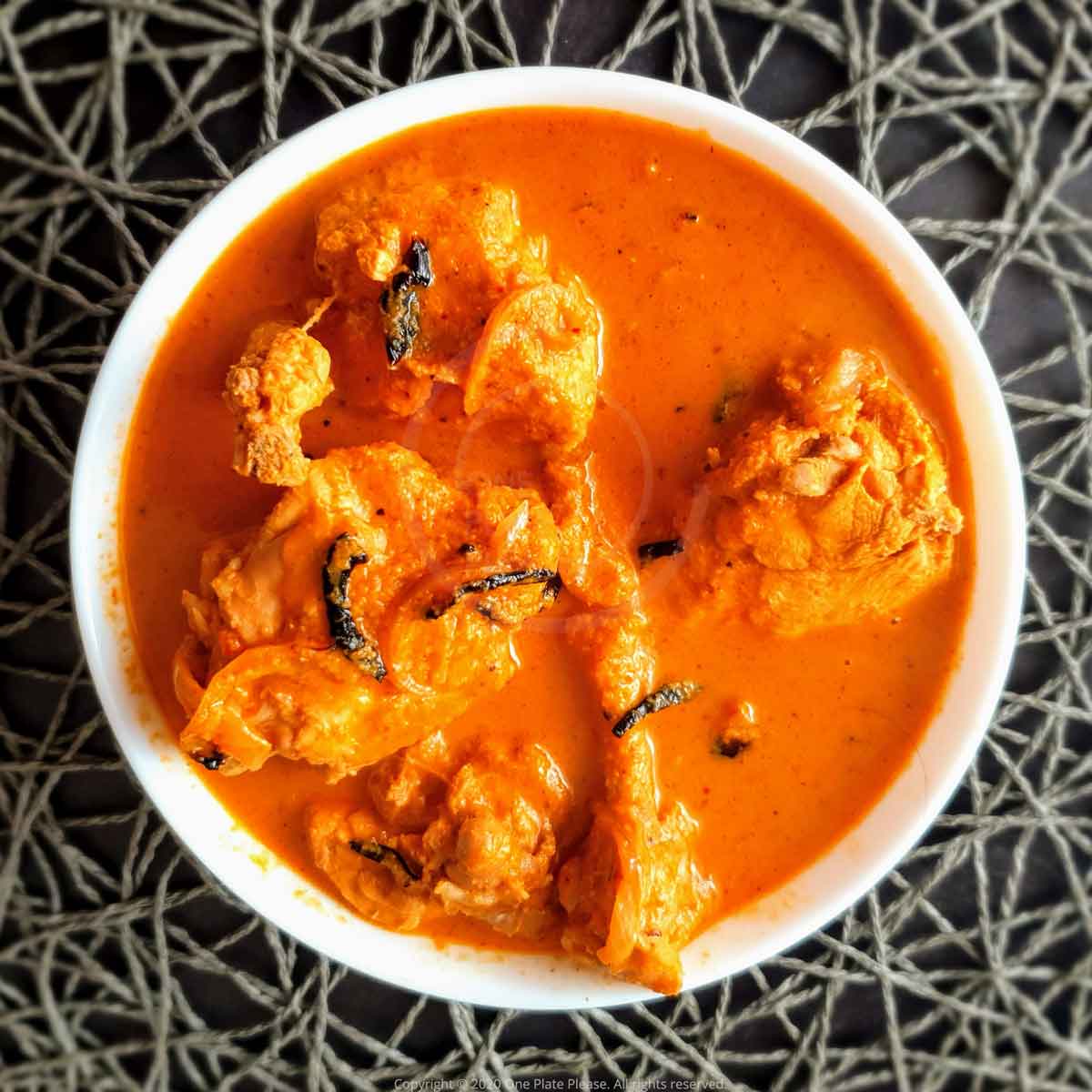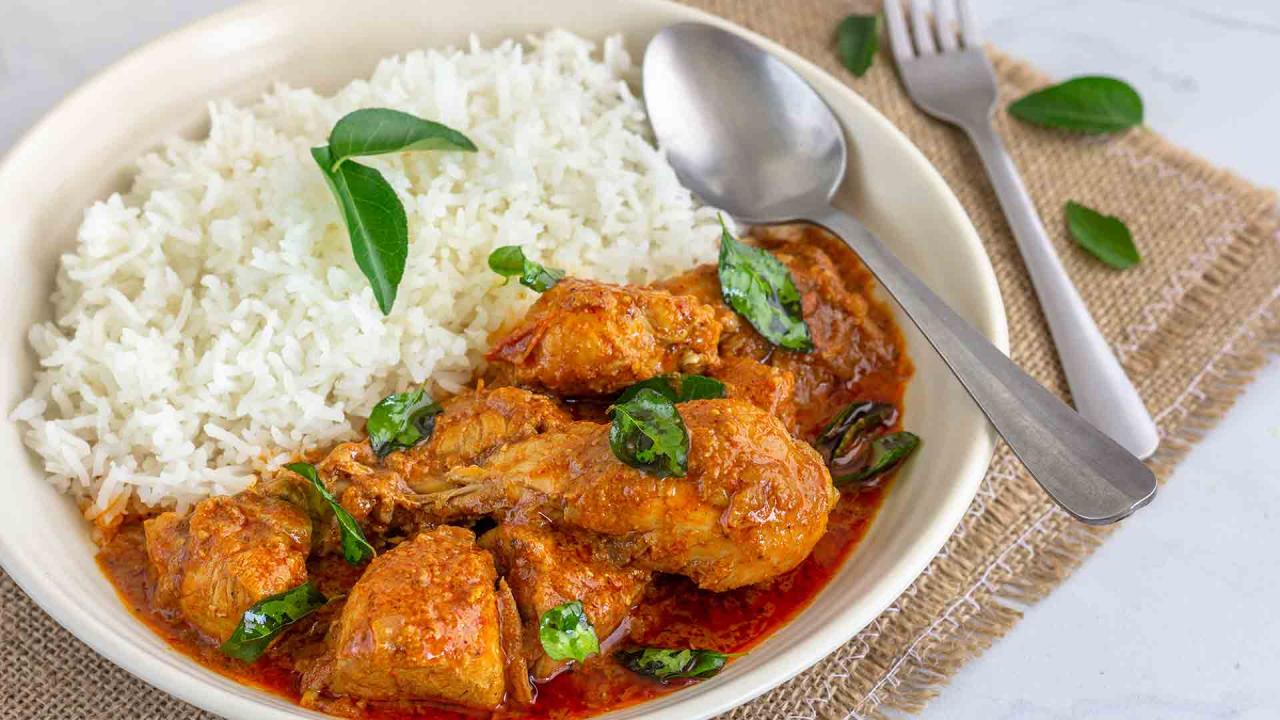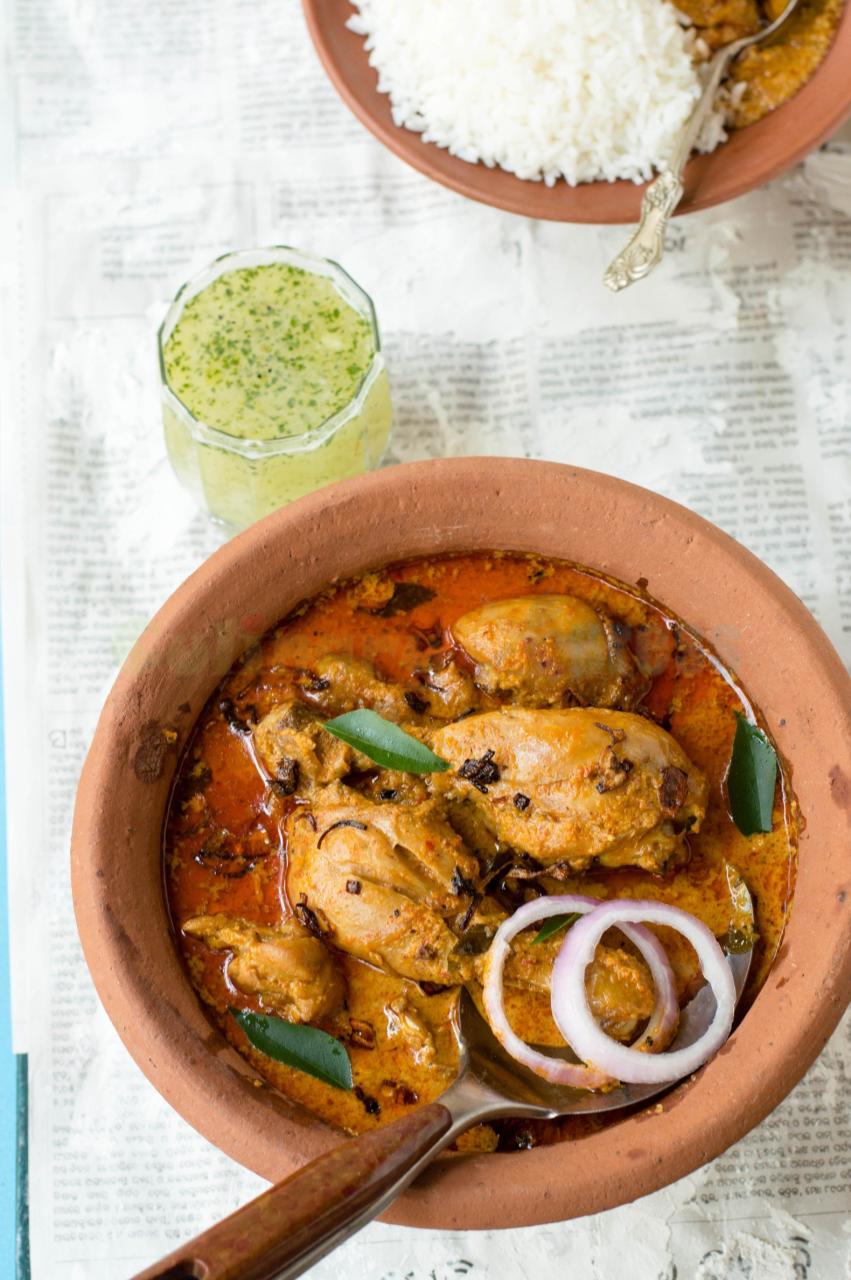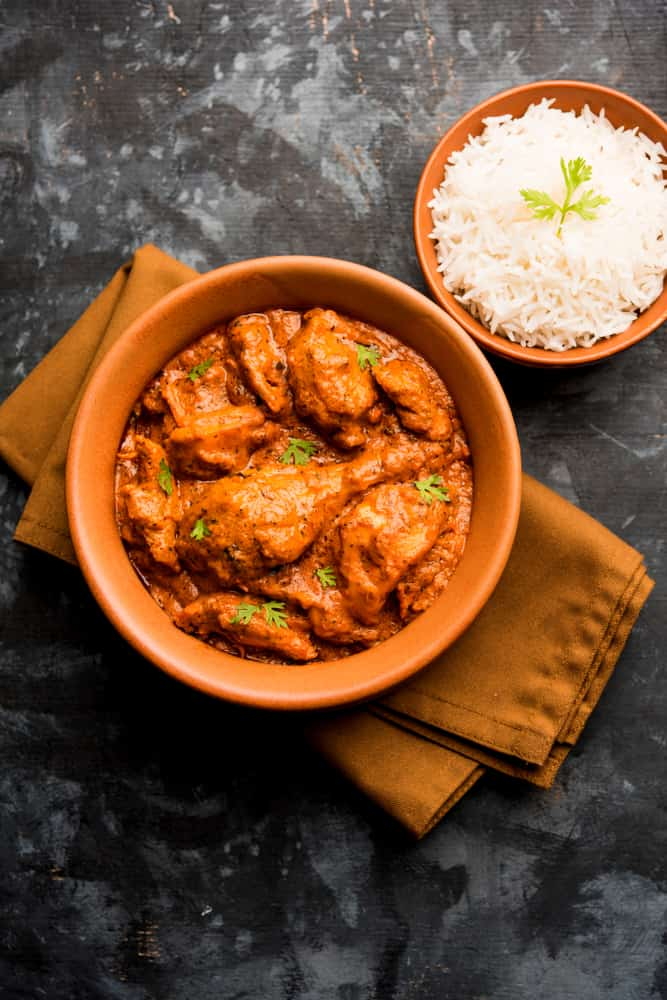Kori Gassi, often known as Chicken Curry, is a renowned dish from the coastal region of Karnataka, particularly Mangalore, which is famous for its distinctive culinary traditions that brilliantly showcase the local flavors and spices. This dish, rooted deeply in the Tuluva Mangalorean cuisine, embodies the robust essence of coastal cooking, reflecting both the geography and the cultural diversity of the area.
In “Kori” meaning chicken in the local language and “Gassi” denoting curry, Kori Gassi is celebrated for its rich, aromatic, and spicy gravy that combines the tanginess of tamarind with the creamy texture of coconut milk. This serves to not only enhance the flavor of the chicken but also to marry various spices unique to Mangalorean cuisine, like Byadagi chillies, fenugreek seeds, coriander seeds, and black peppercorns, among others.
The curry’s depth comes from a specially prepared masala paste made by blending roasted spices together with coconut—a hallmark of many dishes from the region. This complex mix provides a layered taste experience, where heat from the chilies balances the sweetness of the coconut, and the tanginess of tamarind cuts through the richness, making for an utterly delicious ensemble.
Traditionally, Kori Gassi is served with Neer Dosa, a type of soft, lacy crêpe made from rice batter, which complements the thick consistency of the curry perfectly. However, it can also be enjoyed with other South Indian staples such as rice or rotis. The dish is not just food; it’s a celebration of Mangalore’s rich heritage, blending simplicity with complexity, and traditional practices with heartfelt cooking.
Kori Gassi Recipe


Kori Gassi
Equipment
- 1 small bowl
- 1 skillet
Ingredients
- 3 tablespoons dried unsweetened coconut
- 3 tablespoons boiling water
- 1 tablespoon seedless tamarind block soaked in 1/4 cup boiling water for 30 minutes
- 4 tablespoons coconut oil divided
- 1 teaspoon mustard seeds
- 3 tablespoons coriander seeds
- 1/2 teaspoon fennel seeds
- 1/2 teaspoon cumin seeds
- 1/2 teaspoon peppercorns
- Pinch ground fenugreek
- 5 or 6 dried Guntur chiles
- 6 garlic cloves minced
- 1 onion chopped
- 3/4 cup water divided
- Handful curry leaves
- 1 large red onion thinly sliced
- 1/2 teaspoon ground turmeric
- 1 pound boneless skinless chicken breast, cut into small pieces
- 2 tomatoes chopped
- 3/4 cup full-fat coconut milk
- 1 teaspoon salt
Instructions
- In a small bowl, combine the coconut and boiling water. Set aside to soak.
- Stir the tamarind and the water it has been soaking in. Using your fingers, remove the tamarind flesh and squeeze the juice from the pods, removing any fibers and membranes as well. Pour the mixture into a fine-mesh strainer set over a bowl and use a spoon to press as much of the pulp as possible through the strainer. Set the tamarind pulp aside.
- In a skillet over medium heat, heat 2 tablespoons of coconut oil.
- Add the mustard seeds and cook until they begin to sputter, about 1 minute.
- Add the coriander seeds, fennel seeds, cumin seeds, peppercorns, and fenugreek. Sauté until fragrant, about 30 seconds.
- Add the Guntur chiles to the skillet and stir-fry for 3 to 4 minutes, until they are slightly browned.
- Drain any remaining water from the coconut and add it to the skillet along with the garlic and chopped onion. Cook for 5 to 6 minutes, until the onion is softened. Transfer the mixture to a bowl and set aside to cool. Once cool, transfer to a blender or food processor, add 1⁄2 cup of water, and process until a smooth paste forms.
- In a wide pot over medium heat, heat the remaining 2 tablespoons of coconut oil.
- Add the curry leaves and fry briefly.
- Add the red onion and turmeric and cook for 5 to 7 minutes, until the onion is browned.
- Add the chicken. Cook for 3 to 4 minutes, until golden and nearly cooked through, stirring continuously.
- Add the tomatoes and cook for 1 to 2 minutes, stirring frequently.
- Add the onion-spice paste and stir well to mix. Use the remaining 1⁄4 cup of water to rinse out the blender jar and add this to the pot as well.
- Stir in the tamarind pulp and coconut milk and bring the curry to a simmer. Remove the pot from the heat and season with the salt.
Notes
Cooking Tips about Kori Gassi

- Quality of Chicken: For Kori Gassi, it’s paramount to use fresh, skinless chicken pieces, preferably a mix of thigh and breast pieces, as they absorb the spices better and provide a richer flavor compared to using only one type.
- Roasting Spices: This dish’s signature flavor comes from its freshly ground masala. Dry roast spices like coriander seeds, cumin seeds, fenugreek seeds, and Byadagi chillies (or any dried red chilies with a mild heat level) before grinding them. This step intensifies their flavors, adding depth to the curry.
- Coconut Basis: Coconut plays a critical role in Kori Gassi – both grated coconut and coconut milk are used. Grating and blending the coconut into a fine paste along with the roasted spices ensures a thick, rich gravy base. Adding coconut milk towards the end of cooking brings creaminess to the dish without overpowering the spices.
- Tamarind Juice: The tanginess of tamarind is vital to balance out the richness of the coconut. Soak a small piece of tamarind in warm water, extract the juice, and strain it into the curry for that essential tangy flavor.
- Simmering: Once you combine the chicken with the masala and coconut milk, allow the curry to simmer on a low flame. This slow-cooked process helps the chicken to become tender and absorb the complex flavors of the spices and coconut.
- Tempering: A final tadka (tempering) of mustard seeds, curry leaves, and a few additional spices in coconut oil, added to the curry, can significantly enhance its aroma and flavor profile, making it more authentic.
- Resting Time: Like many curries, Kori Gassi benefits from some resting time after cooking. Letting it sit for a while before serving helps the flavors meld together better, enhancing the overall taste.
- Serving Suggestions: Traditionally, Kori Gassi is served with Neer Dosa, a soft, lacy crepe made from rice. However, it also pairs well with other South Indian staples such as rice, rotis, or even a bowl of simple steamed basmati rice.
- Garnish: Before serving, garnish the curry with fresh curry leaves or coriander leaves to add freshness and color. A squeeze of fresh lime juice can also elevate the flavors just before serving.
Serving suggestions about Kori Gassi

- With Neer Dosa: Traditionally, Kori Gassi is served with Neer Dosa, a thin, lacy crepe made from rice batter. The soft texture of Neer Dosa absorbs the curry’s flavors, making each bite a delightful experience.
- With Steamed Rice: A bowl of plain steamed rice serves as a perfect base for Kori Gassi, allowing the rich and spicy curry to shine. The simplicity of rice balances the complexity of the curry’s flavors.
- Mangalorean Roti (Rotti): Try serving Kori Gassi with Mangalorean rotti, such as Akki Rotti (rice flatbread) or Ragi Rotti (finger millet flatbread), for an authentic regional dining experience. These breads add a nice textural contrast and soak up the curry effectively.
- With Sannas: Sannas, idli-like steamed rice cakes that are slightly sweet and fermented, can also accompany Kori Gassi. Their fluffy texture and slight sweetness provide a counterpoint to the spicy curry.
- Basmati Rice or Jeera Rice: For a more aromatic option, pair Kori Gassi with basmati rice or jeera (cumin) rice. The fragrant rice varieties complement the deep flavors of the curry without overpowering them.
- With Appam: Another exquisite pairing is Kori Gassi with appam, a type of pancake made from fermented rice batter and coconut milk. The edges are thin and crispy, while the center is thick and soft, making it ideal for dipping into the curry.
- As Part of a Thali: Serve Kori Gassi as part of a larger Mangalorean or South Indian thali. Include other regional dishes like vegetable stir-fries, pickles, papadums, and a refreshing salad to create a balanced and varied meal experience.
- With Idiyappam: Idiyappam, also known as string hoppers, made from rice flour pressed into noodle form and then steamed, can be a delightful pairing with Kori Gassi. Its light and delicate texture makes it a great carrier for the curry.
Top 5 FAQs about Kori Gassi

- What is Kori Gassi? Kori Gassi, originating from the coastal region of Karnataka, specifically Mangalore, is a popular dish in Tuluva Mangalorean cuisine. “Kori” means chicken, and “Gassi” refers to curry in the local language. The dish is known for its rich, aromatic, and spicy gravy, which blends the tanginess of tamarind with the creamy texture of coconut milk, along with roasted spices unique to Mangalorean cuisine like Byadagi chillies, coriander seeds, and fenugreek seeds.
- How do I achieve the authentic taste of Kori Gassi? To get that authentic taste of Kori Gassi, focus on quality ingredients like fresh chicken and freshly grated coconut. Roast the spices before grinding them into a masala paste, which is then blended with coconut to form the base of the curry. The tanginess from tamarind and the creaminess from coconut milk should be balanced well to achieve the perfect flavor profile. A slow cooking process allows the chicken to absorb the complex mix of flavors thoroughly.
- What are the best accompaniments for Kori Gassi? Traditionally, Kori Gassi is served with Neer Dosa, which is a soft, lacy crêpe made from rice batter. However, it also pairs beautifully with steamed rice, rotis, or other South Indian staples like Ragi Mudde (finger millet balls). The curry’s rich gravy complements these accompaniments, making for a fulfilling meal.
- Can I prepare Kori Gassi without coconut? While coconut plays a crucial role in Kori Gassi, providing both texture and taste, if you need to avoid it due to dietary restrictions or personal preferences, consider substituting with almond milk or cashew paste for creaminess. However, keep in mind that this will alter the traditional flavor to some extent.
- How can I adjust the spice level in Kori Gassi according to my preference? The spice level in Kori Gassi mostly comes from Byadagi chillies, which are known for their deep red color and moderate heat. To adjust the spice level, modify the quantity of chillies used. If less heat is preferred, deseed the chillies before using them in the masala paste. You can also add a bit more coconut milk to mellow down the spice.
Kori Gassi, emblematic of Mangalore’s culinary richness, is more than just a dish—it’s a celebration of the coastal region’s vibrant flavors, traditions, and the artistry inherent in Tuluva Mangalorean cuisine. This Chicken Curry stands as a testament to the intricate blending of local spices, coconut’s creaminess, and the tanginess of tamarind, crafting a harmony of flavors that is both complex and deeply satisfying.

Leave a Reply